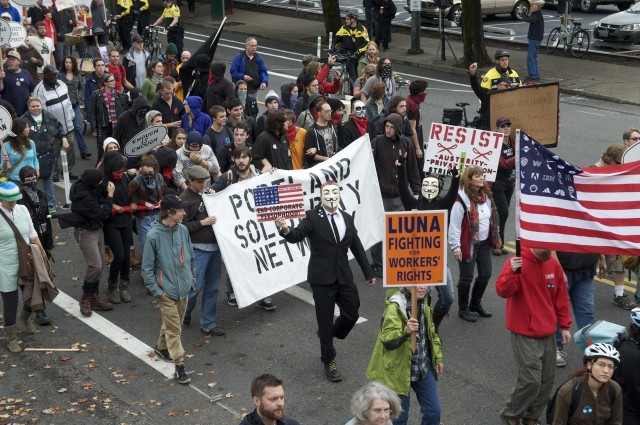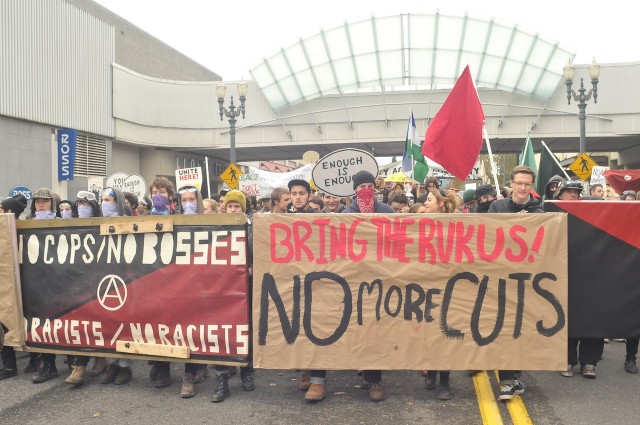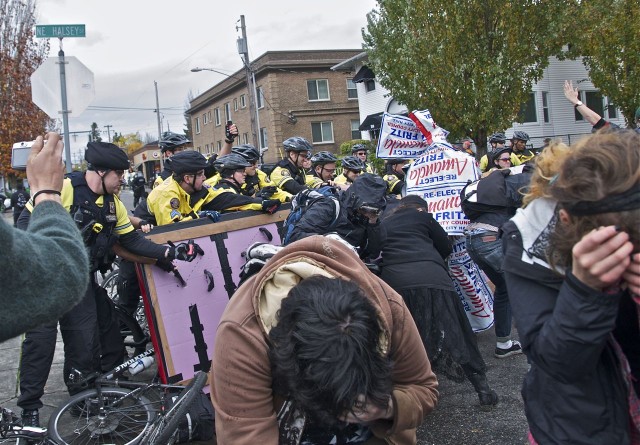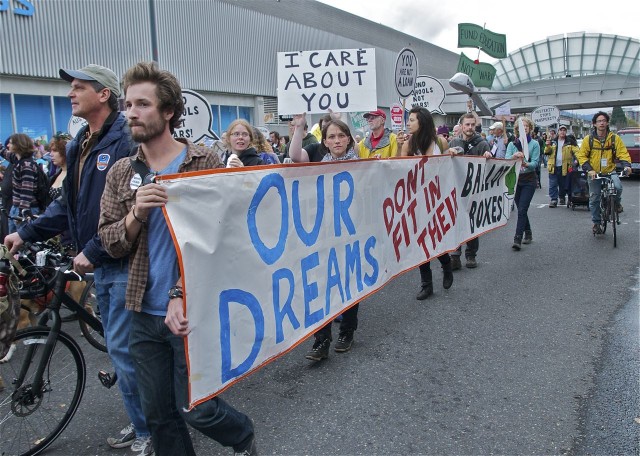By Kari Koch
There were several critical successes of N3—the November 3rd Solidarity Against Austerity mobilization—including mobilizing 1200 people in the streets, putting the concept of austerity into mainstream conversation in Portland as a program of an economic system that is fundamentally flawed, engaging dozens of new folks in mobilization organizing, and building working relationships between organizers who emerged from the Occupy movement and the institutionalized Left.
There was also significant friction in the organizing of N3 that deserves reflection, specifically around the role and functionality of the Portland Action Lab (PAL). The role of PAL in particular seemed to be a source of confusion within the institutionalized Left and merits some flushing out through public dialogue so that we can all be clear next time, should there be a next time, and so that we can more accurately understand when and how it makes sense to engage the PAL network.
The framework of the PAL organizing was muddled for the November 3rd action. People who were engaged in various pieces of the organizing expressed in the debrief that they felt disconnected from a deep understanding of the purpose of the day, the priorities of the PAL network, and general information from the other working groups. The lack of consistency in participating organizers, the short amount of time spent in the large group during meetings, and the role that “autonomy” played in the organizing and on the day of action all contributed to these feelings of disconnection.
As one of the few people deeply involved in organizing all three of PAL’s actions, I would like to offer my thoughts, understandings, and assessments on PAL, N3, and the direction of the organizing for this day of action, as they relate to the initial intentions of PAL. I welcome dialogue and conversation about all of this.
Goals & Priorities of PAL
The primary goals of the Solidarity Against Austerity day of action were to organize a mobilization based in direct action through affinity groups that focused on the issue of austerity, specifically as it relates to debt and education. Particularly, we wanted to highlight “austerity” to make it visible and present it as a target (relating it to issues that affect people’s lives); build support for the growing student anti-debt movement, or student power movement; and harness energy around anti-austerity into on-going organizing.
The general purpose of PAL is to coordinate mass mobilizations. We function as a direct action network that can have stable infrastructure with name recognition that is available for movement purposes. The Action Lab has organized three actions and in each instance the priority and process of our work has been to identify an issue and recruit and coordinate affinity groups that use direct action to target economic institutions. The express purpose has typically been to disrupt the flow of business as usual on those days of action. PAL has also coordinated with affinity groups to participate in the march itself to help provide structure and a physical buffer between the march crowds and the police, who are known violent aggressors. The march uses the affinity group actions as a way to determine the best route and locations for stops. Simply, the actions of affinity groups are the priority of the march and the disruptive (or productive) direct actions are generally seen as the most important aspects of the days of action.

Photo by Chase
Our collective reflections from the F29 Shut Down the Corporations day of action identified the desire to avoid having actions be “one off” affairs; instead it is more strategic to organize actions that contribute a surge of attention or capacity of other organizations doing ongoing work. This was incorporated into the vision for N3 by offering a coordinated space after the action where people interested in anti-austerity work could come together, discuss, plan, and hear what campaigns currently exist.
This is the model of PAL. It rests on the need for direct actions. Otherwise we are just a march and rally, which while valuable, is not the purpose of this network. Building on a foundation of direct action is what has allowed our model to be guided by a fluid connection between groups and organizations, and an express understanding that people at PAL actions will be pushing the bounds of the law and challenging institutions of capital. This is, at least, the intention. Ultimately it is up to small groups of well-organized people to execute these actions.
Arguably this is much more of a vision than the reality of the three actions PAL has planned, specifically that the affinity groups in whom this vision rests have not taken on doing militant direct action as often as we might have liked (though certainly some have). This has led to critiques that the PAL mobilizations are not militant enough or that civil disobedience style direct actions do not adequately challenge the system. I would agree, the original vision of PAL is not perfected but ultimately we can use this infrastructure to move closer to actualizing the original vision.
PAL clearly states in our founding documents that we believe direct action is at the heart of social change, and the more this direct action can be disruptive, creative, and strategic, the more powerful it is. PAL is a direct action network that coordinates mass mobilizations, not a mobilization network that offers space for direct action. Though, again, those coordinating the infrastructure of PAL can only execute this vision through the recruitment of affinity groups willing to take militant action.
The two options above became conflated on N3 because of the range of political leadership in the room and because no affinity groups came forward to do direct actions. Organizers attempted to recruit several high-functioning organizations to engage in strategic and militant direct actions that would advance their ongoing efforts and be an action that would anchor the day in a visual representation of what it looks like to either challenge austerity or build our community’s alternatives. These attempts were not successful and in the end only a handful of groups signed on to do any action, and most of those actions were based in street theater. While this is exciting and welcome — street theater energizes a march and serves an important purpose–the vision is for there to be a balance of militancy and symbolic action.

Photo by PNW Free Press
I think the other reason for difficulty in organizing direct action and affinity groups on N3 was the topic itself. Austerity is both broad and amorphous. What does one target that embodies austerity? There are a lot of options: banks, empty buildings, broken-down infrastructure, interests of privatization, epicenters of wealth. In the end, groups had a difficult time nailing down targets and when they did, it was often without the willingness to act militantly in opposition to those targets. This is not to judge those groups too harshly — I believe strategy trumps militant lashing out most days of the week, but the fact that we couldn’t find this capacity in any affinity groups became a serious flaw in our plans.
Who’s In The Room Matters
The vision of N3 as a day of direct action was lost through both poor internal communication and the divergent political elements coming to the table together with different visions of how N3 might meet all their personal and organizational desires (for instance, the media team debated whether to call it a march and rally or day of action when there was originally no doubt about the intentions of the day to be about action). Many of the people involved previously with PAL actions, and those that were radicalized in the Occupy movement, saw this as a day of action to challenge institutions of power and stand up to the police as needed to meet our goals, while those involved in N3 who came from places like trade unions, Jobs with Justice, and other community groups were much more conservative in their approach. Much of the institutionalized Left originally pushed back against this action being right before the election and then focused on traditional soft actions (finger wagging in elected officials’ offices). To their credit, many unions and community groups endorsed the action despite the initial reservations, which showed the weight of the rank and file members from those organizations pushing for radical action within their institutions. The efforts of the rank-and-file of the organizations and unions deserve immense credit — getting some of these unions signed on is no small task! Although the endorsements of N3 were primarily statements of support for the perceived idea of N3 rather than mobilization for direct action.
These tensions were signs of political divisions in the room, tensions that previous actions had smoothed over with a wild sense of urgency and the momentum of forces like Occupy opening the door for militancy. Additionally, in the two previous PAL actions, the core organizing body established an approach that prioritized direct action and anti-capitalist analysis, the core leadership roles were held by people who embodied that general political analysis and came out of radical grassroots movements. This was not the case with N3. The organizing space was filled in with self-selected leadership that came from across the spectrum of the ‘left’ and did not have an historical sense of what the Action Lab held as core values in past actions. Avoiding these tensions required political leadership from a solid core of people committed to holding the “PAL model”, but such leadership did not exist. This was due both to the fact that leadership from past PAL actions did not return to participate in N3, nor did they provide transitional support for other folks stepping into their roles, and because the people who formed the idea of Solidarity Against Austerity opened up the organizing space broadly before the vision was solidified.
The political divisions became stark when the police attacked the front line of the march and pepper sprayed dozens of youth and comrades, taking their sturdy banners.
The Police
The police see the sturdy banners as a useful tool for the movement, so on N3 they confiscated banners from marchers in the park before the rally. As the police took the banners, they made it clear that they could take anything they wanted away from anyone at the park at any time. This included the metal poles of the Veterans for Peace flags, the wooden picket sticks on virtually every sign in every march, the bullhorns, and anything else they deem “dangerous” or “a nuisance” in the moment. It’s no surprise that the state is constantly assessing our movement and looking for ways to both remove advantages that we might gain and to establish a dynamic of “good protester/bad protester” so as to pit us against each other.
The tragedy with N3 is that many individuals and organizations took the bait and somehow managed to envision a situation in which marchers with banners were antagonizing the police in such a way that it then became their fault when the police enacted violence against our comrades. As a person at the front lines of the march, I can say definitively that these perceptions are horrifyingly misconstruing events of the day; and as the cop-talker, the person assigned by the group to have a line of communication with the police, I have significant insight into the events of the day. The bottom line is this — the police wanted to confiscate all the sturdy banners and indicated to their officers that they should block our route and use necessary force and pepper spray to do so. We, of course, did not know this until after the fact. The police established a situation that was most likely to result in a confrontation. People and groups have successfully and without being pepper sprayed used these sturdy banners in many actions and marches. It is beyond disgusting to blame these folks now for using a successful and tested tactic. Yet, these sorts of accusations were what was coming out of the institutionalized Left after the action — aimed directly at PAL, affinity groups, youth, ‘occupiers’, and, of course, anarchists. Had this been a conversation of strategy, I think we could have had a productive and useful discussion, because we did have a strategy and it did involve banners, and, ultimately, it could have been better. But the critiques were not about strategy. They were hurtful knee jerk reactions not based in honesty or reality, but on perception and judgement.
This, I suppose, is not surprising. We’ve seen similar couching and reactions from non-profit and ‘peace’ organizations in the past, but it is disappointing and a step backward in our movement building efforts. This is regression toward a non-profit model that reinforces reformist notions and doesn’t encourage militant action for fear of losing big financial backers (one piece what is often called the non-profit industrial complex), to trade unions aligned with politicians, and to the tired old violence/non-violence conversation that is a dead weight on our movement. Occupy and the social uprising of the past year, perhaps unwittingly, challenged these solidified dynamics and entrenched practices and fears. The social movement is strong and the divisions are not insurmountable, but this, to me, felt like a serious blow.
Next
All these foundations, difficulties, and real life outcomes beg the question of whether or not the PAL model is functional.
Has the moment passed where enough groups are capable of mobilizing for simultaneous strategic direct action under the same umbrella? Was that a construct of Occupy that is currently out of touch? Or did this ever really exist?
Even the previous PAL actions were light on strategic direct actions that have consequences and targets, and N3 had none. The effort should be made to transition in one of several directions. I don’t think that it makes sense to ditch PAL altogether, but it is clear that the infrastructure of a ‘direct action network’ cannot hold its shape, principles, or vision without people taking on leadership that carry those elements into the organizing space and through the action.
Possible New Directions
Despite any difficulties or mishaps on the part of the N3 organizing, we have an on-going opportunity to utilize the structure of PAL to do more mobilizations or to provide strength to existing organizing efforts. In the spirit of experimentation, here are a few ideas for the future of the Action Lab.
Focus all the energy of PAL organizing on affinity group actions and use the element of surprise to have the effect of significant shut down. Take the march organizing and the public face out of the picture to allow for more vibrant direct action coordination. This has the added benefit of being a new tactic that the city and police will be unprepared for.
Organize the march and rally as militant direct action. The West Coast Port Shutdown in Dec 2012 was a good example of what this could look like in real life. Instead of thinking of the actions as separate, work with a group of people to organize one strategic action that focuses on having a concrete or financial impact on a specific target. Identify the target that appeals to a broad spectrum of people willing to take action, then organize with those folks for a militant march or action.
As the ports come around again as an issue of the intersection of worker power, community control of the commons, environmental justice, and capital distribution the conversation about focusing on one mighty target from lots of different political angles becomes increasingly relevant.
I actually think that N3 was a success despite its shortcomings. Austerity exists as a program of capitalism that is moving through our community, and we put that on the table in real terms. The organizing meetings for N3 were huge, active, and brought many folks into organizing roles who had little previous experience. The media coverage was excellent. The Portland Action Lab continued to build it’s strong public reputation for successful actions and mobilizations. This organizing rebuilt momentum from the summer (even though I never personally felt a summer slow down, I hear that’s a common perception).
Wherever we go, this is all an experiment. We put together ideas, try our hand at organizing, work to construct actions based in principles and vision of building a strong social movement that can advance the struggle toward liberation, and ultimately we inch closer to understanding where to go with all this vibrant energy that fills our collectives, fills our homes, and fills our streets.










